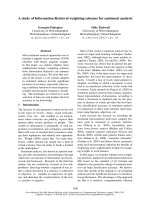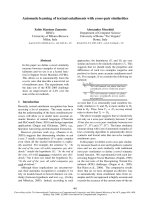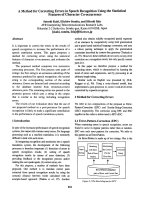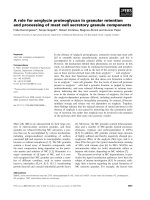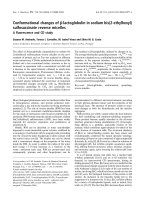Báo cáo khoa học: "A Corpus of Textual Revisions in Second Language Writing" pdf
Bạn đang xem bản rút gọn của tài liệu. Xem và tải ngay bản đầy đủ của tài liệu tại đây (154.74 KB, 5 trang )
Proceedings of the 50th Annual Meeting of the Association for Computational Linguistics, pages 248–252,
Jeju, Republic of Korea, 8-14 July 2012.
c
2012 Association for Computational Linguistics
A Corpus of Textual Revisions in Second Language Writing
John Lee and Jonathan Webster
The Halliday Centre for Intelligent Applications of Language Studies
Department of Chinese, Translation and Linguistics
City University of Hong Kong
{jsylee,ctjjw}@cityu.edu.hk
Abstract
This paper describes the creation of the first
large-scale corpus containing drafts and fi-
nal versions of essays written by non-native
speakers, with the sentences aligned across
different versions. Furthermore, the sentences
in the drafts are annotated with comments
from teachers. The corpus is intended to sup-
port research on textual revision by language
learners, and how it is influenced by feedback.
This corpus has been converted into an XML
format conforming to the standards of the Text
Encoding Initiative (TEI).
1 Introduction
Learner corpora have been playing an increasingly
important role in both Second Language Acquisition
and Foreign Language Teaching research (Granger,
2004; Nesi et al., 2004). These corpora contain
texts written by non-native speakers of the lan-
guage (Granger et al., 2009); many also annotate
text segments where there are errors, and the cor-
responding error categories (Nagata et al., 2011). In
addition, some learner corpora contain pairs of sen-
tences: a sentence written by a learner of English
as a second language (ESL), paired with its correct
version produced by a native speaker (Dahlmeier
and Ng, 2011). These datasets are intended to sup-
port the training of automatic text correction sys-
tems (Dale and Kilgarriff, 2011).
Less attention has been paid to how a language
learner produces a text. Writing is often an iterative
and interactive process, with cycles of textual revi-
sion, guided by comments from language teachers.
Discipline # drafts
Applied Physics 988
Asian and International Studies 410
Biology 2310
Building Science and Technology 705
Business 1754
Computer Science 466
Creative Media 118
Electronic Engineering 1532
General Education 651
Law 31
Linguistics 2165
Management Sciences 1278
Social Studies 912
Total 13320
Table 1: Draft essays are collected from courses in vari-
ous disciplines at City University of Hong Kong. These
drafts include lab reports, data analysis, argumentative
essays, and article summaries. There are 3760 distinct
essays, most of which consist of two to four successive
drafts. Each draft has on average 44.2 sentences, and the
average length of a sentence is 13.3 words. In total, the
corpus contains 7.9 million words.
Understanding the dynamics of this process would
benefit not only language teachers, but also the de-
sign of writing assistance tools that provide auto-
matic feedback (Burstein and Chodorow, 2004).
This paper presents the first large-scale corpus
that will enable research in this direction. After a re-
view of previous work (§2), we describe the design
and a preliminary analysis of our corpus (§3).
248
Figure 1: On top is a typical draft essay, interleaved with comments from a tutor (§3.2): two-digit codes from the
Comment Bank are enclosed in angled brackets, while open-ended comments are enclosed in angled brackets. On the
bottom is the same essay in TEI format, the output of the process described in §3.3.
2 Previous Research
In this section, we summarize previous research on
feedback in language teaching, and on the nature of
the revision process by language learners.
2.1 Feedback in Language Learning
Receiving feedback is a crucial element in language
learning. While most agree that both the form and
content of feedback plays an important role, there
is no consensus on their effects. Regarding form,
some argue that direct feedback (providing correc-
tions) are more effective in improving the quality of
writing than indirect feedback (pointing out an er-
ror but not providing corrections) (Sugita, 2006), but
others reached opposite conclusions (Ferris, 2006;
Lee, 2008).
Regarding content, it has been observed that
teachers spend a disproportionate amount of time
on identifying word-level errors, at the expense of
those at higher levels, such as coherence (Furneaux
et al., 2007; Zamel, 1985). There has been no large-
scale empirical study, however, on the effectiveness
of feedback at the paragraph or discourse levels.
2.2 Revision Process
While text editing in general has been ana-
lyzed (Mahlow and Piotrowski, 2008), the nature
of revisions by language learners — for example,
whether learners mostly focus on correcting me-
chanical, word-level errors, or also substantially re-
organize paragraph or essay structures — has hardly
been investigated. One reason for this gap in the
literature is the lack of corpus data: none of the ex-
isting learner corpora (Izumi et al., 2004; Granger
et al., 2009; Nagata et al., 2011; Dahlmeier and Ng,
2011) contains drafts written by non-native speakers
that led to the “final version”. Recently, two cor-
pora with text revision information have been com-
piled (Xue and Hwa, 2010; Mizumoto et al., 2011),
but neither contain feedback from language teach-
ers. Our corpus will allow researchers to not only
examine the revision process, but also investigate
any correlation with the amount and type of feed-
back.
3 Corpus Description
We first introduce the context in which our data was
collected (§3.1), then describe the kinds of com-
ments in the drafts (§3.2). We then outline the
conversion process of the corpus into XML format
(§3.3), followed by an evaluation (§3.4) and an anal-
ysis (§3.5).
3.1 Background
Between 2007 and 2010, City University of Hong
Kong hosted a language learning project where
English-language tutors reviewed and provided
feedback on academic essays written by students,
249
Paragraph level Sentence level Word level
Coherence: more 680 Conjunction missing 1554 Article missing 10586
elaboration is needed
Paragraph: new paragraph 522 Sentence: new sentence 1389 Delete this 9224
Coherence: sign posting 322 Conjunction: wrong use 923 Noun: countable 7316
Coherence: missing 222 Sentence: fragment 775 Subject-verb 4008
topic sentence agreement
Table 2: The most frequent error categories from the Comment Bank, aimed at errors at different levels.
most of whom were native speakers of Chi-
nese (Webster et al., 2011). More than 300 TESOL
students served as language tutors, and over 4,200
students from a wide range of disciplines (see Ta-
ble 1) took part in the project.
For each essay, a student posted a first draft
1
as
a blog on an e-learning environment called Black-
board Academic Suite; a language tutor then directly
added comments on the blog. Figure 1 shows an ex-
ample of such a draft. The student then revised his or
her draft and may re-post it to receive further com-
ments. Most essays underwent two revision cycles
before the student submitted the final version.
3.2 Comments
Comments in the draft can take one of three forms:
Code The tutor may insert a two-digit code, repre-
senting one of the 60 common error categories
in our “Comment Bank”, adopted from the
XWiLL project (Wible et al., 2001). These cat-
egories address issues ranging from the word
level to paragraph level (see Table 2), with
a mix of direct (e.g., “new paragraph”) and
indirect feedback (e.g., “more elaboration is
needed”).
Open-ended comment The tutor may also provide
personally tailored comments.
Hybrid Both a code and an open-ended comment.
For every comment
2
, the tutor highlights the prob-
lematic words or sentences at which it is aimed.
Sometimes, general comments about the draft as a
whole are also inserted at the beginning or the end.
1
In the rest of the paper, these drafts will be referred to “ver-
sion 1”, “version 2”, and so on.
2
Except those comments indicating that a word is missing.
3.3 Conversion to XML Format
The data format for the essays and comments was
not originally conceived for computational analysis.
The drafts, downloaded from the blog entries, are in
HTML format, with comments interspersed in them;
the final versions are Microsoft Word documents.
Our first task, therefore, is to convert them into a
machine-actionable, XML format conforming to the
standards of the Text Encoding Initiative (TEI). This
conversion consists of the following steps:
Comment extraction After repairing irregularities
in the HTML tags, we eliminated attributes that
are irrelevant to comment extraction, such as
font and style. We then identified the Comment
Bank codes and open-ended comments.
Comment-to-text alignment Each comment is
aimed at a particular text segment. The text
segment is usually indicated by highlighting
the relevant words or changing their back-
ground color. After consolidating the tags for
highlighting and colors, our algorithm looks
for the nearest, preceding text segment with a
color different from that of the comment.
Title and metadata extraction From the top of the
essay, our algorithm scans for short lines with
metadata such as the student and tutor IDs,
semester and course codes, and assignment and
version numbers. The first sentence in the es-
say proper is taken to be the title.
Sentence segmentation Off-the-shelf sentence
segmentators tend to be trained on newswire
texts (Reynar and Ratnaparkhi, 1997), which
significantly differ from the noisy text in our
corpus. We found it adequate to use a stop-list,
supplemented with a few regular expressions
250
Evaluation Precision Recall
Comment extraction
- code 94.7% 100%
- open-ended 61.8% 78.3%
Comment-to-text alignment 86.0% 85.2%
Sentence segmentation 94.8% 91.3%
Table 3: Evaluation results of the conversion process de-
scribed in §3.3. Precision and recall are calculated on
correct detection of the start and end points of comments
and boundaries.
that detect exceptions, such as abbreviations
and digits.
Sentence alignment Sentences in consecutive ver-
sions of an essay are aligned using cosine simi-
larity score. To allow dynamic programming,
alignments are limited to one-to-one, one-to-
two, two-to-one, or two-to-two
3
. Below a cer-
tain threshold
4
, a sentence is no longer aligned,
but is rather considered inserted or deleted. The
alignment results are stored in the XCES for-
mat (Ide et al., 2002).
3.4 Conversion Evaluation
To evaluate the performance of the conversion algo-
rithm described in §3.3, we asked a human to manu-
ally construct the TEI XML files for 14 pairs of draft
versions. These gold files are then compared to the
output of our algorithm. The results are shown in
Table 3.
In comment extraction, codes can be reliably
identified. Among the open-ended comments, how-
ever, those at the beginning and end of the drafts
severely affected the precision, since they are of-
ten not quoted in brackets and are therefore indistin-
guishable from the text proper. In comment-to-text
alignment, most errors were caused by inconsistent
or missing highlighting and background colors.
The accuracy of sentence alignment is 89.8%,
measured from the perspective of sentences in Ver-
sion 1. It is sometimes difficult to decide whether a
sentence has simply been edited (and should there-
fore be aligned), or has been deleted with a new sen-
tence inserted in the next draft.
3
That is, the order of two sentences is flipped.
4
Tuned to 0.5 based on a random subset of sentence pairs.
3.5 Preliminary Analysis
As shown in Table 4, the tutors were much more
likely to use codes than to provide open-ended com-
ments. Among the codes, they overwhelmingly em-
phasized word-level issues, echoing previous find-
ings (§2.1). Table 2 lists the most frequent codes.
Missing articles, noun number and subject-verb
agreement round out the top errors at the word level,
similar to the trend for Japanese speakers (Lee and
Seneff, 2008). At the sentence level, conjunctions
turn out to be challenging; at the paragraph level,
paragraph organization, sign posting, and topic sen-
tence receive the most comments.
In a first attempt to gauge the utility of the com-
ments, we measured their density across versions.
Among Version 1 drafts, a code appears on aver-
age every 40.8 words, while an open-ended com-
ment appears every 84.7 words. The respective fig-
ures for Version 2 drafts are 65.9 words and 105.0
words. The lowered densities suggest that students
were able to improve the quality of their writing af-
ter receiving feedback.
Comment Form Frequency
Open-ended 47072
Hybrid 1993
Code 88370
- Paragraph level 3.2%
- Sentence level 6.0%
- Word level 90.8%
Table 4: Distribution of the three kinds of comments
(§3.2), with the Comment Bank codes further subdivided
into different levels (See Table 2).
4 Conclusion and Future Work
We have presented the first large-scale learner cor-
pus which contains not only texts written by non-
native speakers, but also the successive drafts lead-
ing to the final essay, as well as teachers’ comments
on the drafts. The corpus has been converted into an
XML format conforming to TEI standards.
We plan to port the corpus to a platform for text
visualization and search, and release it to the re-
search community. It is expected to support stud-
ies on textual revision of language learners, and the
effects of different types of feedback.
251
Acknowledgments
We thank Shun-shing Tsang for his assistance with
implementing the conversion and performing the
evaluation. This project was partially funded by a
Strategic Research Grant (#7008065) from City Uni-
versity of Hong Kong.
References
Jill Burstein and Martin Chodorow. 2004. Automated
Essay Evaluation: The Criterion online writing ser-
vice. AI Magazine.
Daniel Dahlmeier and Hwee Tou Ng. 2011. Grammat-
ical Error Correction with Alternating Structure Opti-
mization. Proc. ACL.
Robert Dale and Adam Kilgarriff. 2011. Helping Our
Own: The HOO 2011 Pilot Shared Task. Proc. Eu-
ropean Workshop on Natural Language Generation
(ENLG), Nancy, France.
Dana Ferris. 2006. Does Error Feedback Help Student
Writers? New Evidence on the Short- and Long-Term
Effects of Written Error Correction. In Feedback in
Second Language Writing: Contexts and Issues, Ken
Hyland and Fiona Hyland (eds). Cambridge Univer-
sity Press.
Clare Furneaux, Amos Paran, and Beverly Fairfax. 2007.
Teacher Stance as Reflected in Feedback on Student
Writing: An Empirical Study of Secondary School
Teachers in Five Countries. International Review of
Applied Linguistics in Language Teaching 45(1): 69-
94.
Sylviane Granger. 2004. Computer Learner Corpus Re-
search: Current Status and Future Prospect. Language
and Computers 23:123–145.
Sylviane Granger, Estelle Dagneaux, Fanny Meunier, and
Magali Paquot. 2009. International Corpus of Learner
English v2. Presses universitaires de Louvain, Bel-
gium.
Nancy Ide, Patrice Bonhomme, and Laurent Romary.
2000. XCES: An XML-based Encoding Standard for
Linguistic Corpora. Proc. LREC.
Emi Izumi, Kiyotaka Uchimoto, and Hitoshi Isahara.
2004. The NICT JLE Corpus: Exploiting the Lan-
guage Learners’ Speech Database for Research and
Education. International Journal of the Computer, the
Internet and Management 12(2):119–125.
Icy Lee. 2008. Student Reactions to Teacher Feedback
in Two Hong Kong Secondary Classrooms. Journal of
Second Language Writing 17(3):144-164.
John Lee and Stephanie Seneff. 2008. An Analysis of
Grammatical Errors in Nonnative Speech in English.
Proc. IEEE Workshop on Spoken Language Technol-
ogy.
Cerstin Mahlow and Michael Piotrowski. 2008. Linguis-
tic Support for Revising and Editing. Proc. Interna-
tional Conference on Computational Linguistics and
Intelligent Text Processing.
Tomoya Mizumoto, Mamoru Komachi, Masaaki Nagata,
and Yuji Matsumoto. 2011. Mining Revision Log of
Language Learning SNS for Automated Japanese Er-
ror Correction of Second Language Learners. Proc.
IJCNLP.
Ryo Nagata, Edward Whittaker, and Vera Sheinman.
2011. Creating a Manually Error-tagged and Shallow-
parsed Learner Corpus. Proc. ACL.
Jeffrey C. Reynar and Adwait Ratnaparkhi. 1997. A
Maximum Entropy Approach to Identifying Sentence
Boundaries. Proc. 5th Conference on Applied Natural
Language Processing, Washington DC.
Yoshihito Sugita. 2006. The Impact of Teachers’ Com-
ment Types on Students’ Revision. ELT Journal
60(1):34–41.
Hilary Nesi, Gerard Sharpling, and Lisa Ganobcsik-
Williams. 2004. Student Papers Across the Cur-
riculum: Designing and Developing a Corpus of
British Student Writing. Computers and Composition
21(4):439–450.
Frank Tuzi. 2004. The Impact of E-Feedback on the Re-
visions of L2 Writers in an Academic Writing Course.
Computers and Composition 21(2):217-235.
Jonathan Webster, Angela Chan, and John Lee. 2011.
Online Language Learning for Addressing Hong Kong
Tertiary Students’ Needs in Academic Writing. Asia
Pacific World 2(2):44–65.
David Wible, Chin-Hwa Kuo, Feng-Li Chien, Anne Liu,
and Nai-Lung Tsao. 2001. A Web-Based EFL Writ-
ing Environment: Integrating Information for Learn-
ers, Teachers, and Researchers. Computers and Edu-
cation 37(34):297-315.
Huichao Xue and Rebecca Hwa. 2010. Syntax-Driven
Machine Translation as a Model of ESL Revision.
Proc. COLING.
Vivian Zamel. 1985. Responding to Student Writing.
TESOL Quarterly 19(1):79-101.
252

